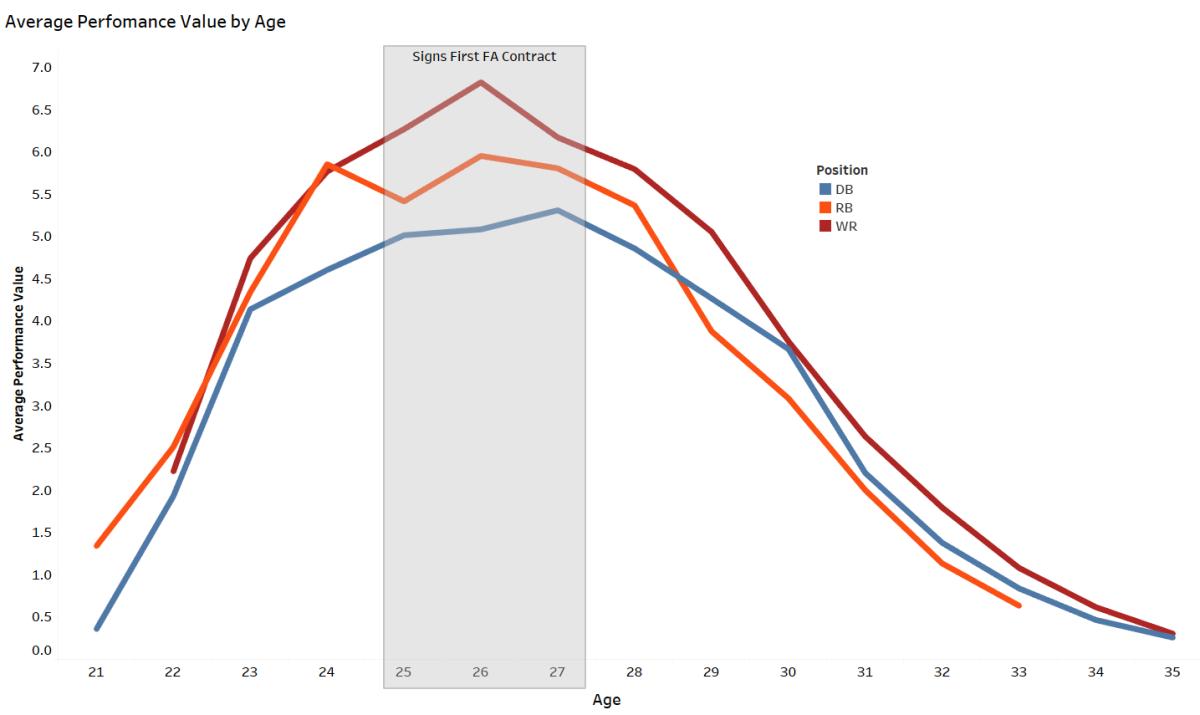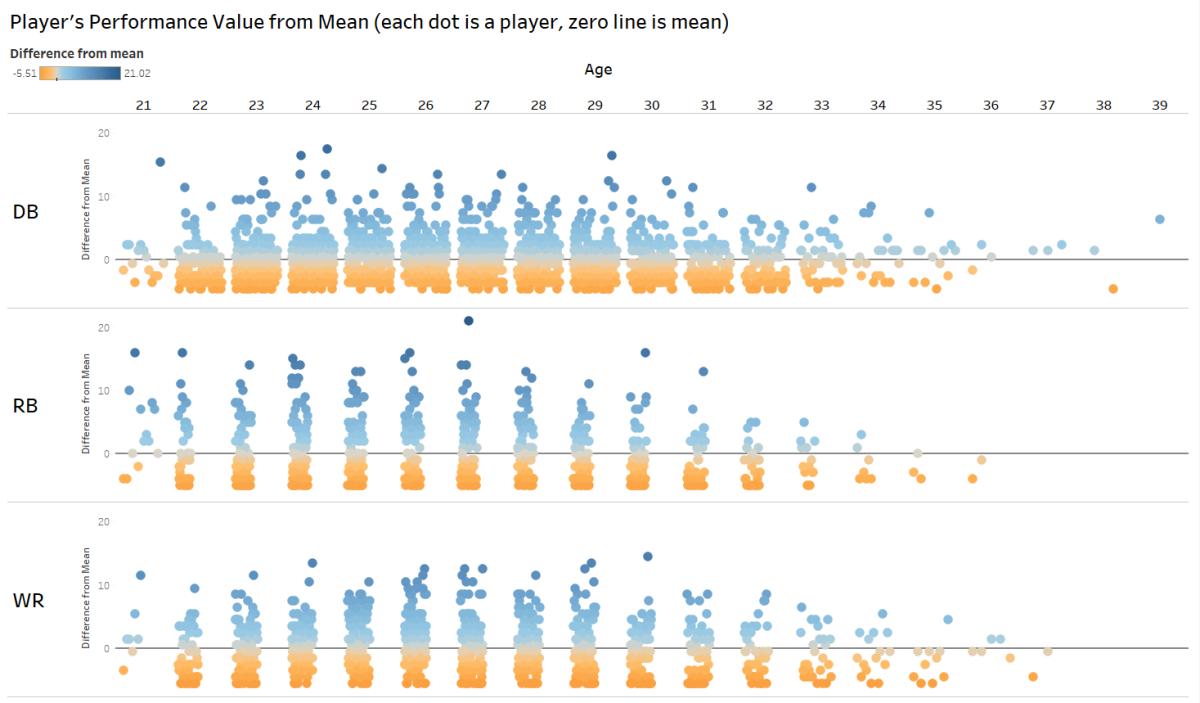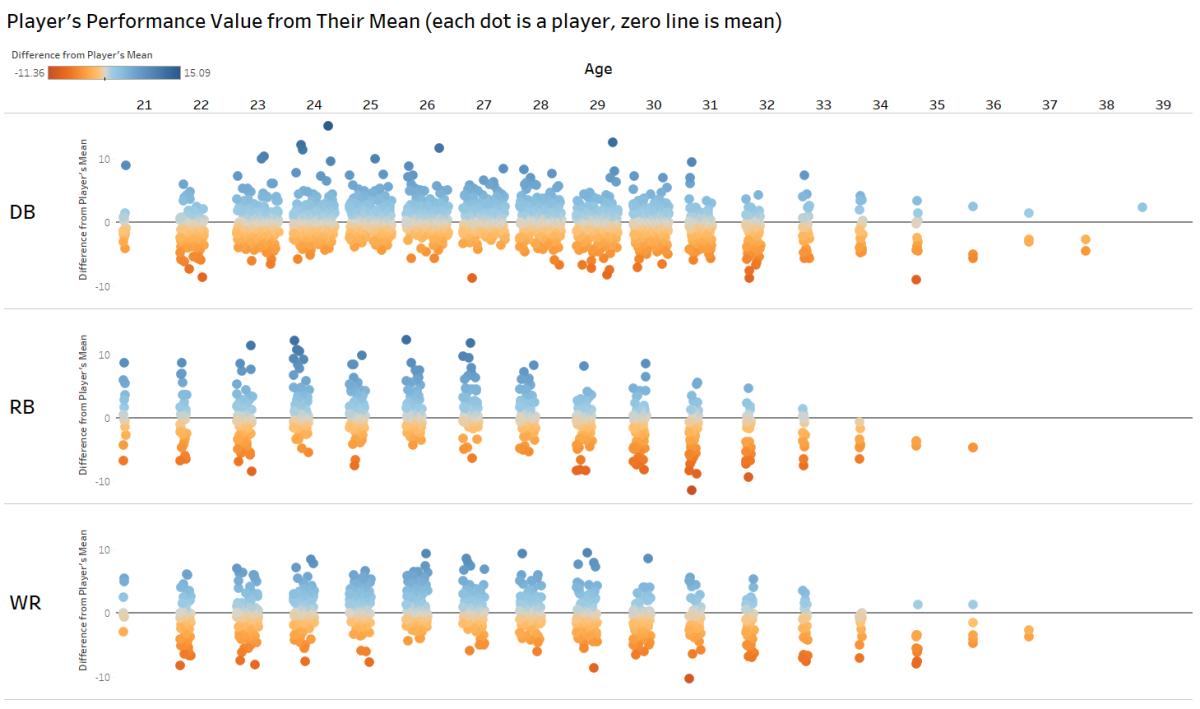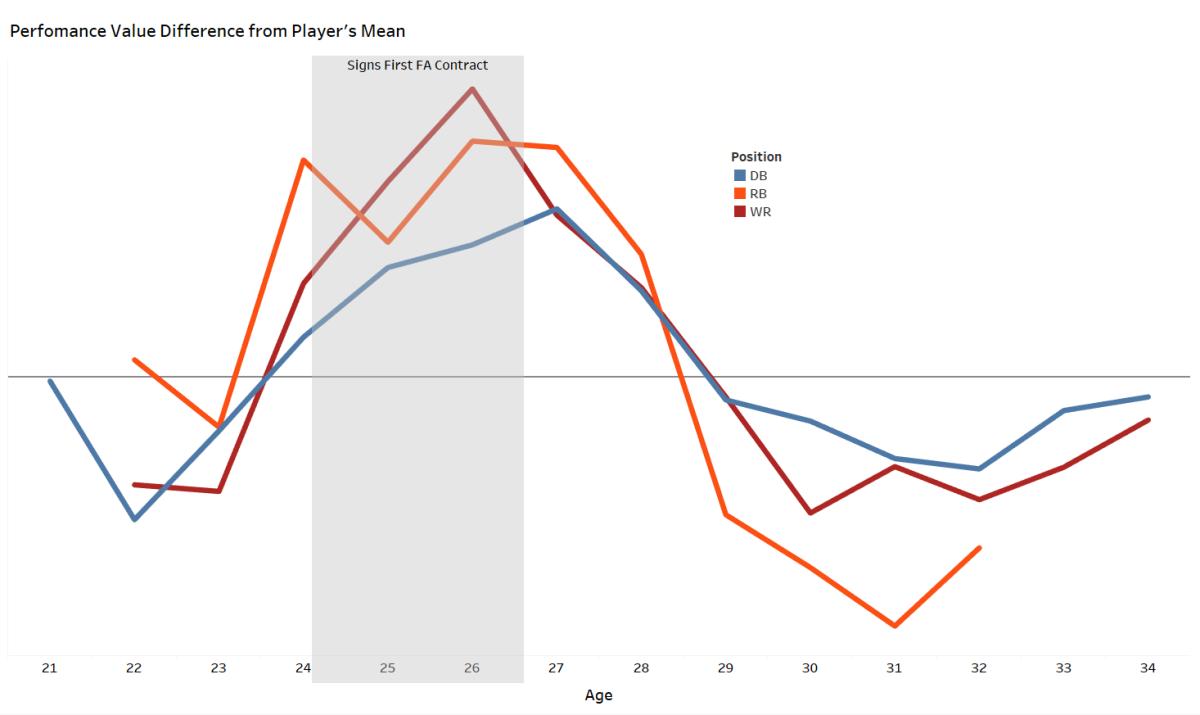Advanced Analytics Reveal Whether Broncos Were Wise to Acquire 28-Year-Old CB A.J. Bouye
The Denver Broncos just traded for A.J. Bouye and with NFL free agency opening in less than two weeks, it would be wise to look at the defensive backs with the same analysis from last week's article on wide receivers.
Although the Bouye acquisition was not a free-agent signing, this analysis will explore whether or not the trade was a smart decision and worth both the draft capital given up and the cost of his 2020 salary.
The defensive backs analysis will still answer the same two questions that were posed when I analyzed the skill positions. At what age does a player’s performance rapidly decline? Does it vary by position?
The next series of graphs include wide receivers and running backs from the first analysis to use as a comparison for defensive backs.
The first graph depicts the average Performance Value by age. Defensive backs peak at age 27 instead of 26 as seen in the WR and RB analysis. DBs tend to peak after their first free-agent contract or at least during the season they signed said contract.
DBs decline more slowly and aren’t in as rapid of a decline as the other two positions until age 30.
Note: Only age periods with at least 15 players who played at that age are included in the below graph.

The next graph is a scatter plot depicting every player in the data set, at every age they played and the difference from the mean at their position for each of those ages. DBs not only enjoy a longer and more productive career as they age, there are many examples of DBs with a Performance Value greater than the position mean after age 30.

The next part of the analysis compares a player to his own performance throughout his career. In this part of the analysis, each player is compared to his mean performance over the entirety of his career.
The following graph is another scatter plot that shows each player by his age and the difference in his Performance Value for that season versus his mean. DBs enjoy longer lifespan in the NFL than running backs and wide receivers.

The next graph depicts the difference in a player’s Performance Value versus his mean. Again, defensive backs performance peaks at 27 years old.
However, after 30 years old, they are below the mean.

The biggest difference when it comes to free-agent DBs compared to RBs and WRs is that realization that their Perfomance Value is still ascending as they receive their first free-agent contract (not their rookie contact). Meaning, DBs are more likely to have a peak season for the team that signs them to their first free-agent contract.
What it Means
All these metrics are important to understand when it comes to DBs and NFL free agency. A team must know when a player's decline will begin so that they can spend money on free agents at the right time.
If a DB is an unrestricted free agent at age 25, then a team can take the risk on giving him a four-year contract because he will likely fulfill that contract with higher than average performance and likely will have a peak season after that contract is signed. That is a good return on the investment.
It is a much bigger risk to sign a DB after the age of 30 because they will typically play below their average performance value.
Why the Bouye Trade was Good
First, there is little financial risk since the Broncos could cut Bouye with no dead cap ramifications. In other words, if he doesn’t play well, he can be cut without it hurting the Broncos' future salary cap.
However, Denver did invest a fourth-round draft pick in hopes that Bouye's future performance will be solid. He will start the season at 29 years old, well into the age that DBs begin to decline.
A deeper dive into Bouye, specifically, shows that he had his peak year at age 26, which also corresponds with the data revealing that the first year after a DB signs his first free-agent contract is his most productive. The two years after his peak season, his Performance Value was at the average for his career (2018 and 2019).
There have been examples where DBs have peaked again or come close to matching the peak season they had earlier in their career, but it is rare. Usually, those are Hall of Fame-caliber players.
Is it possible the Bouye could come close to his peak season again? Yes, but it is unlikely. More probable is that he will play near or slightly above his average for the next two to three years, followed by a decline into being a below-average DB.
If that is how it unfolds, the fourth-round pick used to acquire for Bouye will have been worth it because it is hard to find a cornerback who can contribute at that level in his first two years in the fourth round.
Broncos Still in the CB Market
Does the trade for Bouye take the Broncos out of the cornerback market? No way. Denver still needs to find another viable starter or at the very least, a solid contributor.
There are some options out there on the free-agent market. Byron Jones has been linked to the Broncos, but the trade for Bouye may have taken Denver out of that high-dollar market. However, Jones is very similar to Bouye.
Jones will turn 28 years old right after the season starts (a year younger than Bouye) and he has had a peak season at age 26. His Performance Value dropped to his average the very next season. It's likely he would contribute to the Broncos in a similar fashion as Bouye, but at a much higher price tag.
Prince Amukamara has been linked to the Broncos due to his past with head coach Vic Fangio. Amukamara will be 31 when the season starts, which is not optimal. He has not had that true peak season, so it is possible that he is in line for a great season later in age, like a few others have in the past.
However, that is unlikely. More likely, Amukamara will continue to decline and would be playing below his average during his contract. For the right price and for a short contract, it may be worth the risk in hopes he has that peak season later in age.
One intriguing free agent flying under everyone’s radar is Eli Apple. He has not lived up to his draft status by any means, but he has not been a bust either. He has had four seasons that are above the average for his position and he is only 24.
There are many examples of CBs who had a Performance Value above the average in the first three or four seasons of their career and had a large peak season between the ages of 25 and 28. Apple is entering the peak age for DBs.
Furthermore, of the 113 DBs in the data who had a similar start to their career as Apple, 49 of them went on to have a better total Performance Value from ages 26-29 than they did to start their career. Only 39 washed out of the league.
Apple is more likely to have a better career after signing his first free-agent contract than washing out of the league. At the right price, he could be a steal.
Now, Apple may not be the best fit for the Fangio defense, but it would behoove the Broncos to look for a CB similar to him to score an under-the-radar signing who surprises.
Next up: Offensive Line
Follow Thomas on Twitter @ThomasHallNFL and @MileHighHuddle.
